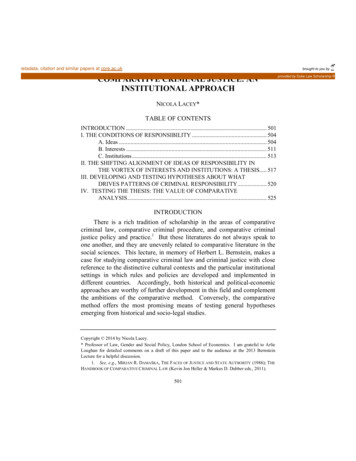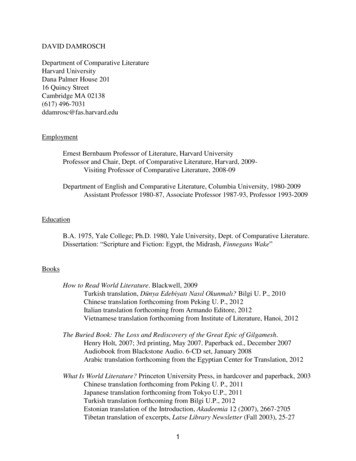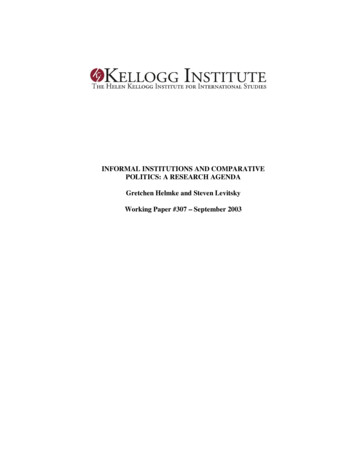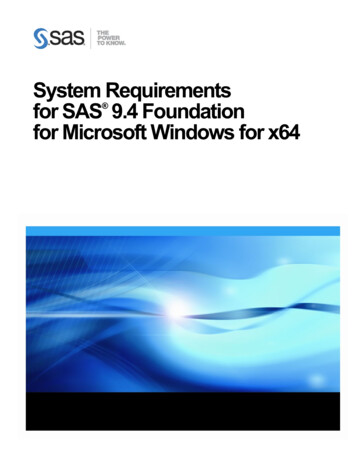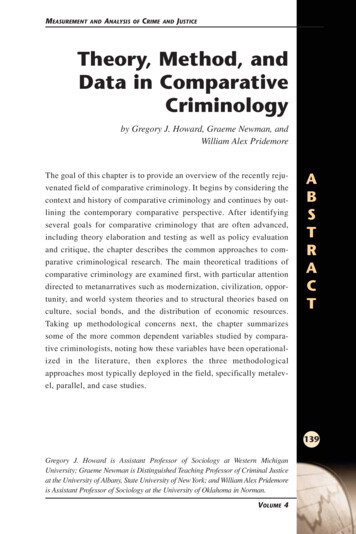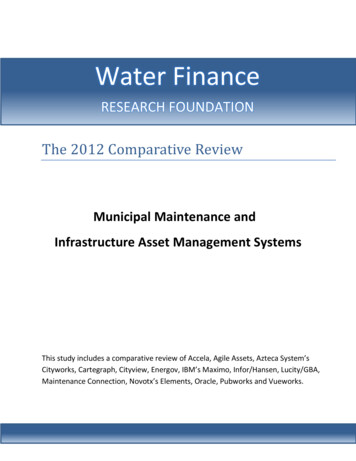
Transcription
Water FinanceRESEARCH FOUNDATIONThe 2012 Comparative ReviewMunicipal Maintenance andInfrastructure Asset Management SystemsThis study includes a comparative review of Accela, Agile Assets, Azteca System’sCityworks, Cartegraph, Cityview, Energov, IBM’s Maximo, Infor/Hansen, Lucity/GBA,Maintenance Connection, Novotx’s Elements, Oracle, Pubworks and Vueworks.
The 2012 Comparative Review of Municipal Maintenanceand Infrastructure Asset Management SystemsABSTRACT: The United States and Canada face tremendous capital outlays to repair andreplace aging municipal and utility infrastructure. Technology is required to better manage thecomplex decision making process for maintenance, operational and capital investments andresource allocation. This study conducted in 2012 comprises a comparative review of the majorcomputerized maintenance management and infrastructure asset management systems used bymunicipal governments and water and wastewater utilities in the United States and Canada. Theobjective of this study is to provide municipal elected officials, public works directors,infrastructure asset managers, maintenance managers, information technology managers, financedirectors and procurement staff an overview of municipal maintenance management andinfrastructure asset management software in a comparative format in preparation for a request forqualifications or proposals. The comparative criteria includes software costs, vendor services,support, specialization, work orders, inventory control, licensing and permitting, conditionassessment, risk management, asset inventory, GIS mapping, Esri GIS integration, 311 systems,mobile devices, Esri GIS ROI and future industry trends. The comparative analysis of coremaintenance management and infrastructure asset management functions was completed for thefollowing 14 software systems in alphabetic order: Accela, Agile Assets, Azteca System’sCityworks, Cartegraph, Cityview, Energov, IBM’s Maximo, Infor/Hansen, Lucity/GBA,Maintenance Connection, Novotx’s Elements, Oracle, Pubworks and Vueworks. Also includedin this study, but not in a comparative format is a discussion on Esri GIS as the recommendedplatform for municipal mapping applications; and Innovyze software offerings for an advancedwet infrastructure/underground network hydraulic modeling decision analytics approach.Water Finance Research Foundation WFRFwww.waterfinanceRF.org21. SUMMARY RESULTS Municipal Maintenance and Infrastructure Asset Management Systems
1. SUMMARY RESULTSThe summary results of the 2012 comprehensive comparative review and study ranks Azteca System’sCityworks maintenance management and infrastructure asset management system as the top selectionfor municipal and utility use. Cityworks has demonstrated strength and longevity in the municipal andutility market place for the last 15 years with a highly developed work order management system, andcan fully leverage an organization’s (ROI) investment in the Esri GIS and the ArcGIS geodatabase asthe asset repository reducing implementation and long-term maintenance cost of ownership issues.Cityworks maintains some of the most advanced LGT (Local Government Templates) with over 630work order templates, 150 service requests with detailed condition assessment inspections. The licensingand permitting functionality is further enhanced by the Esri GIS Centric approach in developingconnectivity of all public assets, infrastructure and activities.SoftwareFunctionalScorePrice ovCartegraphLucity (GBA)PubworksMaintenanceVueworksAgile 9179788279828178686161585642*Adjusted Price Score weighted 20%31. SUMMARY RESULTS Municipal Maintenance and Infrastructure Asset Management Systems
2. INTRODUCTIONIn recent years municipalities and water and wastewater systems have struggled significantly inmanaging the complex and diverse assets that are within their jurisdictions for which they areaccountable. Great strides have been made to develop programs and systems to improve costefficiencies but core work order management software system functionality by itself did notaddress the growing needs of infrastructure asset management practices. During the most recentfive years since the worldwide economic decline, which in part continues today, municipalitiesand utilities at all levels have faced severe revenue short falls. The actions taken to maintainbaseline services involved delaying hundreds of millions of dollars a year in needed maintenanceactivities and deferring critical capital projects. Efforts made at the state, regional, county, andlocal levels to better manage assets and allocate limited resources to high profile failing assetswere met with a high degree of frustration due to inconsistent and outdated practices, neglecteddata tracking and storing, and a lack of data integration abilities with silo/stranded datathroughout many departments.Asset ManagementInfrastructure asset management programs, offered by different consulting firms, should still befocused on managing assets in a way in which the investment for each asset can be optimizedproducing a reduction in capital budgets and operating expenditures, an efficient and costeffective maintenance program based on risk and an overall reduction in the cost of capital. Onecommon problem has been when engineering drives the capital agenda and the needs ofoperations and maintenance are overlooked. Likewise, when the financial tracking and planningfunctions are also neglected, true enterprise asset management decision making cannot occur. Amultidisciplinary approach at a corporate level is highly recommended to create a consistentmanagement-wide effort to guide investments and resource allocation.Comprehensive asset management professionals understand these concepts and have a globalperspective and the ability to customize solutions to each municipality. These professionalspossess the expertise in and understanding of the International Infrastructure ManagementManual (IIMM), which is essentially the bible of asset management. This training is critical inestablishing the foundational knowledge of the comprehensive process of modern asset42. INTRODUCTION Municipal Maintenance and Infrastructure Asset Management Systems
management. The basic foundation as well as the expectations should be that asset managementas a philosophy is a process of continuous improvement and change.In the United States and Canada, the definition of asset management will continue to be definedby the software tools each organization selects as a means to improve asset performance andmanage costs. A reduction of cost can be defined as either a short-term gain or a long-term gainor both. The logic entails that if an asset is not maintained correctly it can fail prematurely.Likewise, an asset replaced prematurely wastes a useful asset and as a result improvedperformance and investment decision making does not occur. Informed decision making canreduce the overall cost of the asset and function to the benefit of the taxpayers. This process isdata intensive and requires the necessary policies, leadership, and structure to meet sustainableinfrastructure objectives. The goal to achieve a sense of sustainable infrastructure requires anoverall plan including asset management planning, which in turn also requires a financial plan, atechnology plan, a service delivery plan, and integration with community planning efforts.Public Asset ManagementThe concept of public asset management strives to combine all infrastructure assets and landbased assets and functions to effectively manage the social and environmental goals of thecommunity while offering an improved management decision making process with publicreview, approval and justification. The current trend is that municipal utilities as capital-intensiveenterprise funds will initiate asset management programs during the economic decline and willlead their general city management counterparts of public works, streets, facilities, fleet, parks,signage, bridges, cemeteries, ports and marinas, into an era of sustainability and infrastructureasset management. The expansive nature of the process places a high level of importance on thetechnology which needs to be applied in a way to gain the greatest benefit overall.Computerized Maintenance Management Systems (CMMS) and Infrastructure AssetManagement Software implementation trends for municipalities demonstrate initial progress inbusiness enterprise funds like water, wastewater, and storm drains migrating efficiencies andpractices to other municipal departments. This system functionality migration trend will continueand can be more readily managed with a GIS centered strategy.52. INTRODUCTION Municipal Maintenance and Infrastructure Asset Management Systems
3. METHODOLOGYThe comparative analysis of core maintenance management and infrastructure asset managementfunctions was completed for the following 14 software systems in alphabetic order: Accela,Agile Assets, Azteca System’s Cityworks, Cartegraph, Cityview, Energov, IBM’s Maximo,Infor/Hansen, Lucity/GBA, Maintenance Connection, Novotx’s Elements, Oracle, Pubworks andVueworks.The comparative criteria includes software costs, vendor services, support, specialization, workorders, inventory, licensing and permitting, condition assessment, risk management, assetinventory, GIS mapping, Esri GIS integration, 311 systems, mobile devices and Esri GIS ROItaking into consideration future industry trends. The four major functional categories include1) Company/Service, 2) Work Management, 3) Asset Management, and 4) GIS.Each major component is ranked 1-5 with a 5 as the highest score. A zero represents a functionnot contained in the software. The Overall Functional Score assumes an even weighting of thefour major functional areas.6COMPANY CIALIZATIONASSET MANAGEMENTCONDITION ASSESSMENTRISK MANAGEMENTASSETINVENTORY/HIERARCHYWORK ORDERSWORK ORDERS AND WORK FLOWINVENTORYLICENSING AND PERMITSGISGIS MAPPINGEsri GIS INTEGRATION311 SYSTEMSMOBILE DEVICESEsri GIS ROI3. METHODOLOGY Municipal Maintenance and Infrastructure Asset Management Systems
4. REVIEW OF SERVICESThe functionality of the core components of a software application is very important, however, theactual success and level of benefit gained is a direct result of the work and support around the planning,implementation, testing and training. The ability for the software vendor to provide enhanced supportand training to ensure the successful implementation is critical. In the area of asset management, dataconversion and a specialization in specific infrastructure types can ensure a higher degree of utilizationof software capabilities.Company Services Overall ScorePubworksCityviewAgile ty 214164. REVIEW OF SERVICES Municipal Maintenance and Infrastructure Asset Management Systems
Company/ServicesThe Company/Service functional category includes Vendor Services and Implementation,Support and Training Services and Company Strength and Specialization. A ranking scoreranging from 1-5 was assigned to software for each of the 3 areas. A “5” score represents thehighest functionality, while a low score represents a marginal level of functionality. If softwaredid not have functionality in a given area then a zero was assigned and calculated into the acleAccelaEnergovInfor/HansenLucity (GBA)ElementsMaintenanceVueworksAgile rksCartegraphMaximoInfor/HansenLucity (GBA)OracleAccelaEnergovMaintenanceAgile elaEnergovInfor/HansenLucity (GBA)MaintenanceAgile 334. REVIEW OF SERVICES Municipal Maintenance and Infrastructure Asset Management Systems
5. REVIEW OF WORK MANAGEMENTA robust Computerized Maintenance Management System (CMMS) with work orders providingthe ability to separate planned or unplanned maintenance costs, builds life cycle cost history,records actual direct costs of the activity, documents the procedures followed, notes the failuremode and primary cause of failure with comments on indirect costs and impacts to customersand possible unproductive time. A basic CMMS alone is not an asset management system. Allof this data enables additional possibilities of failure, causal, consequence and efficiencyanalysis.Work Management Overall ScoreCityviewAgile acleInforMaximoCartegraphLucity (GBA)AccelaCityworks0924681012145. REVIEW OF WORK MANAGEMENT Municipal Maintenance and Infrastructure AssetManagement Systems16
Work ManagementThe Work Management functional category consisted of Work Orders and Work Flow,Inventory Control, and Licensing and Permitting. A ranking score ranging from 1-5 wasassigned to software for each of the 3 areas. A “5” score represents the highest functionality,while a low score represents a marginal level of functionality. If software did not havefunctionality in a given area then a zero was assigned and calculated into the overall scoring.Work eMaximoLucity (GBA)CartegraphElementsOraclePubworksVueworksAgile celaMaximoLucity nergovMaintenanceVueworksAgile ksAccelaCityviewEnergovCartegraphLucity enanceVueworksAgile Assets5. REVIEW OF WORK MANAGEMENT Municipal Maintenance and Infrastructure AssetManagement Systems55554444430000
6. REVIEW OF ASSET MANAGEMENTCondition assessment can be defined as a method that establishes the current condition of assetsas a means of prioritizing and forecasting maintenance and rehabilitation efforts. Conditionassessment can help managers understand the level of asset deterioration and the riskmanagement impact on the probability and consequence of failure. The Asset Inventory orRegistry is central to any asset management program or strategy. An asset register is a systematicrecording of all assets an organization owns or for which it has responsibility.Asset Management Overall ScoreCityviewElementsAgile AssetsVueworksMaintenancePubworksLucity orks0112468101214166. REVIEW OF ASSET MANAGEMENT Municipal Maintenance and Infrastructure Asset ManagementSystems
Asset ManagementAsset Management functional category includes Condition Assessment capabilities, RiskManagement, and Asset Inventory and Hierarchy. A ranking score ranging from 1-5 wasassigned to software for each of the 3 areas. A “5” score represents the highest functionality,while a low score represents a marginal level of functionality. If software did not havefunctionality in a given area then a zero was assigned and calculated into the overall scoring.Condition graph4Energov5Maximo5Infor5Oracle5Lucity (GBA)4Maintenance4Pubworks4Agile Assets3Vueworks312Risk graph4Energov5Maximo5Infor5Oracle5Lucity (GBA)4Maintenance4Pubworks4Vueworks4Agile Assets3Asset aximoOracleInforLucity (GBA)PubworksAgile AssetsElementsMaintenanceVueworks505455544433336. REVIEW OF ASSET MANAGEMENT Municipal Maintenance and Infrastructure Asset ManagementSystems
7. REVIEW OF GISInvesting in a complete GIS system with full functionality produces an overall reduction inoperating and maintenance costs and can become the foundation of a lower cost assetmanagement system. Technology has increased the operating efficiencies of municipalities andutilities by converting manual office process from paper to an intelligent automation system. GISis a unique system of hardware, software and data used to create, store, edit, organize,manipulate and analyze information within a geographic area. GIS offers the ability to visualizemodels of the physical infrastructure and related activities in a map view.GIS Overall ScoreElementsMaintenanceCityviewAgile AssetsVueworksPubworksLucity orks01351015207. REVIEW OF GIS Municipal Maintenance and Infrastructure Asset Management Systems25
GISThe GIS (Geographical Information System) functional category consists of GIS Mappingfeatures, Esri GIS integration, 311 System Abilities, Mobile Devices Enhancements, and EsriGIS ROI (Return on Investment) considerations. A “5” score represents the highest functionality,while a low score represents a marginal level of functionality. If software did not havefunctionality in a given area then a zero was assigned and calculated into the overall scoring.GIS imoInfor/HansenLucity (GBA)OracleVueworksAgile i imo4Infor/Hansen 4Lucity (GBA)4Oracle4Agile view0311 worksCityworksMaximoLucity (GBA)VueworksCityviewAgile AssetsElementsMaintenance55555544443200Mobile DevicesAccela5Maximo5Infor/Hansen 5Oracle5Cityworks4Agile Assets4Energov4Cartegraph3Cityview3Lucity (GBA)3Maintenance 3Pubworks3Vueworks2Elements0GIS has been able to meet the increased demand for mobility and information sharing. Manyapplications for asset maintenance and management purposes have been developed by softwarecompanies in order to improve the transactional cost of public accountability. Some of these features canalso be accessed through 3rd party vendors. Municipalities and utilities have benefited from 311 citizeninformation, request and tracking systems as well as mobile remote business functionality via handheldmobile devices. 311 capabilities and mobile device initiatives are continually improving for top vendors.147. REVIEW OF GIS Municipal Maintenance and Infrastructure Asset Management Systems
Esri GIS ROIGIS offers a return on investment (ROI) and these operational savings will continue almostindefinitely. Municipalities and utilities in the United States and Canada rely on the industryleader Esri (Environmental Systems Research Institute) GIS for their GIS software. Localgovernments and utilities benefit overall with standardization and common open standards forconsistency which helps achieves lower-costs with the economies of scale. Under this GISCentric approach, the Esri GIS ArcGIS geodatabase is the feature database for storing the allasset attributes. Additionally, there is no redundancy for data storage (no reliance on views, datamapping, database triggers, or "transparent" links). All feature (asset) data is fully user-definableand customizable without vendor support. This would include common standardization absentexpensive non-proprietary feature data model format, including data names, fields, tables,relationships, and other data design elements.Esri GIS senLucity e AssetsCityview1553333333222211Esri PARTNER LEVELPlatinumGoldSilverGoldmemberGold-member-8. REVIEW OF COST FACTORS Municipal Maintenance and Infrastructure Asset ManagementSystems
8. REVIEW OF COST FACTORSOverall Scores and Rankings normally are based on the functional categories scores andaverages. Under this review, the four major functional categories were weighted evenly. Theelement of cost adds additional complexity to the analysis. Most municipalities and utilities willnormally focus on the core functionality of the software in order to meet all current and futurebusiness needs before reviewing bids or prices. The price component can be challengingconsidering there are the basic user licenses, software and maintenance costs and agreementscombined with phased implementations, modular selections, data clean up, data conversion,systems integrations, testing and training. This study focuses on the common costs; however, it isvery important to note that if various modules are selected and integrated, the costs ofimplementation are normally significant higher.Cost FactorsAgile nergovLucity acle16(5 is a high age3Average3Average4High4High5High5High8. REVIEW OF COST FACTORS Municipal Maintenance and Infrastructure Asset ManagementSystems
Cost FactorsLikewise, when system integration and conversion is required for many different systems andseveral modules, the initial implementation and long-term system synchronization andmaintenance of redundant databases can raise the total cost of ownership significantly. This isvery true in the area of licensing and permitting. Every municipality and utility has a degree ofdata clean up due to neglect or inconsistent policies and practices concerning work orderhistories and inspection recording and asset data collection. One specific area of concern hasbeen the development of the asset inventory and the connectivity and integration with GISsoftware.17 Municipal Maintenance and Infrastructure Asset Management Systems
9. Esri GIS ArcGIS: Geodatabase managementArcGIS for Desktop includes comprehensive professional GIS applications that support a number ofGIS tasks, including mapping, data compilation, analysis, geodata and image management, andgeographic information sharing. ArcGIS for Desktop is the platform that GIS professionals use tomanage their GIS workflows and projects and to build data, maps, models, and applications. It is alsothe starting point and the foundation for deploying GIS across organizations and onto the web. It is usedto publish and share geographic information with others.ArcGIS for Server includes capabilities for managing multiuser geodatabases in a number of DBMSs.When you need a large multiuser geodatabase that can be edited and used simultaneously by many usersor that can be synchronized across many copies (replicas) of the database, the geodatabase provides agood solution.ArcGIS for Server adds the ability to manage shared, multiuser geodatabases as well as support for anumber of critical multiuser database workflows. The ability to leverage your organization's enterpriserelational database is a key advantage. Multiuser, transactional geodatabases work with a variety ofDBMS storage models (for example, IBM DB2, Informix, Oracle, PostgreSQL, and SQL Server).Geodatabases take full advantage of underlying DBMS architectures to support the following: Extremely large, continuous GIS databases Many simultaneous users Long transactions and versioned workflows Relational database support for GIS data management (providing the benefits of a relationaldatabase for scalability, reliability, security, backup, integrity, and so forth) SQL types for spatial in all supported DBMSs (Oracle, SQL Server, PostgreSQL, Informix, andDB2) High performance that can scale to a very large number of usersDBMSs are efficient at retrieving and working with records containing the type of large geometryelements required for GIS data. In addition, GIS database sizes can be much larger, and the number ofsupported users greater, than with file-based GIS datasets.189. Esri GIS ArcGIS: Geodatabase management Municipal Maintenance and Infrastructure AssetManagement Systems
10. PROFILE: Azteca Systems CITYWORKSCityworks5432101910. PROFILE: Azteca Systems CITYWORKS Municipal Maintenance and Infrastructure AssetManagement Systems
10. PROFILE: ACCELAAccela5432102010. PROFILE: ACCELA Municipal Maintenance and Infrastructure Asset Management Systems
10. PROFILE: AGILE ASSETSAgile Assets5432102110. PROFILE: AGILE ASSETS Municipal Maintenance and Infrastructure Asset Management Systems
10. PROFILE: CARTEGRAPHCartegraph5432102210. PROFILE: CARTEGRAPH Municipal Maintenance and Infrastructure Asset Management Systems
10. PROFILE: ELEMENTSElements5432102310. PROFILE: ELEMENTS Municipal Maintenance and Infrastructure Asset Management Systems
10. PROFILE: ENERGOVEnergov5432102410. PROFILE: ENERGOV Municipal Maintenance and Infrastructure Asset Management Systems
10. PROFILE: INFOR/HANSENInfor5432102510. PROFILE: INFOR/HANSEN Municipal Maintenance and Infrastructure Asset ManagementSystems
10. PROFILE: LUCITY (GBR)Lucity (GBA)5432102610. PROFILE: LUCITY (GBR) Municipal Maintenance and Infrastructure Asset Management Systems
10. PROFILE: MAINTENANCE CONNECTIONMaintenance5432102710. PROFILE: MAINTENANCE CONNECTION Municipal Maintenance and Infrastructure AssetManagement Systems
10. PROFILE: IBM MAXIMOMaximo5432102810. PROFILE: IBM MAXIMO Municipal Maintenance and Infrastructure Asset Management Systems
10. PROFILE: ORACLEOracle5432102910. PROFILE: ORACLE Municipal Maintenance and Infrastructure Asset Management Systems
10. PROFILE: PUBWORKSPubworks5432103010. PROFILE: PUBWORKS Municipal Maintenance and Infrastructure Asset Management Systems
10. PROFILE: VUEWORKSVueworks5432103110. PROFILE: VUEWORKS Municipal Maintenance and Infrastructure Asset Management Systems
10. PROFILE: CITYVIEWCityview5432103210. PROFILE: CITYVIEW Municipal Maintenance and Infrastructure Asset Management Systems
11. WATER and SEWER UTILITIES: INNOVYZEInnovyze is a leading global provider of wet infrastructure business analytics software solutionsdesigned to meet the technological needs of water and wastewater utilities, government industries, andengineering organizations worldwide.Underground infrastructure is rapidly deteriorating and many utilities struggle with developing arehabilitation and replacement program that addresses the most critical pipes in the system. Many capitalimprovement programs spend millions of dollars annually, but often do little to lower total system risk.CapPlan Water offers utilities the tools in one off-the-shelf software package to build or refine thecapital improvement plans to provide maximum benefit for the lowest cost. Determining the likelihoodof failure for a pressurized underground water pipe is a critical task. CapPlan Water combinesinfrastructure, hydraulic, spatial, and historical data from numerous sources to estimate for likelihood offailure. Understanding the consequences of a pipe failing is critical to determining its replacementpriority. CapPlan Water has powerful tools to assess the hydraulic, geographic, spatial, and publicrelations criticality of each pipe in the system—including automatically taking each pipe out of serviceand determining the hydraulic and water quality consequences. A Risk Factor is determined for eachpipe based on the Likelihood and Consequence of Failure. CapPlan Water has a wide range of budgetingoptions available to evaluate the highest priority pipes within existing budgets and to determinenecessary budgets over the long-term to mitigate high risk levels.3311. WATER and SEWER UTILITIES: INNOVYZE Municipal Maintenance and Infrastructure AssetManagement Systems
12. REFERENCESThe Water Research Foundation would like to acknowledge and thank the researchers and contributorsto this study. American Public Works Association (APWA) members www.apwa.netCalifornia Society of Municipal Finance Officers (CSMFO) members www.csmfo.orgGovernment Finance Officers Associations (GFOA) members www.gfoa.orgInterviews of software marketing and technical staff at industry yweb.comwww.vueworks.comwww-01.ibm.com3412. REFERENCES Municipal Maintenance and Infrastructure Asset Management Systems
WFRFThe Water Finance Research Foundation (www.Water FinanceRF.org) is a non-profit organizationdedicated to finding solutions which help local governments and utilities address the challenges of aginginfrastructure, funding and a declining workforce. The WFRF supports and provides research, surveys,analysis, publications and training concerning best practices for municipal and utility management.The WFRF promotes municipal infrastructure asset management practices for state, county and localgovernments which increase efficiencies while reducing long-term operations, maintenance, and capitalcosts. A special focus is on wet infrastructure which includes water, wastewater, storm drain and reuse.A core program also includes creating opportunities for the next generation to gain knowledge andexperience through research and publication opportunities. The WFRF also strives to help municipalitiesand utilities explore financing and funding solutions which includes rate and fee increases, debtrefinancing, private-public partnerships, grants and other innovative programs.The Water Finance Research Foundation is proud to sponsor and promote in 2013, The American PublicInfrastructure Asset Management Association (API-AMA). API-AMA focuses on traditional municipalinfrastructure asset management combined with public asset management (the connectivity of assetswith business activities and citizens). The evolution and power of GIS and other technologies hasinc
Infrastructure Asset Management Systems This study includes a comparative review of Accela, Agile Assets, Azteca System's ityworks, artegraph, ityview, Energov, I M's Maximo, Infor/Hansen, Lucity/GA, . infrastructure asset management software in a comparative format in preparation for a request for qualifications or proposals. The .



